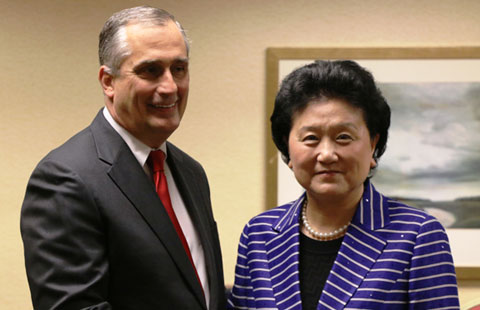Fashion industry ready for change in China
Updated: 2015-06-19 11:31
By Wang Ying in Shanghai(China Daily USA)
|
|||||||||
China's fashion industry could lead other industries in the country into higher end, and Shanghai is poised to be at the forefront, according to a new report.
By analyzing its fashion industry characteristics, China stands ready to shift its clothing industry from manufacturing-centered to design-focused, according to the Blue Book of China's Fashion Industry 2014-2015, a publication published by a research center jointly established by China Europe International Business School (CEIBS) and the People's Government of Jing'an district of Shanghai.
The Blue Book also suggested the increase savvy consumers will create opportunities for average brands.
This is the only thorough research report on China's fashion industry released after the global financial crisis in 2008. Based on abundant data, case studies and experts' research and analysis, the report presents a perspective on China's fashion industry development.
For example, the book advised China to include fashion industry development into the nation's mid- to long-term plan, and to choose some model cities for the fashion industry.
Meanwhile, the report indicates that with the rapid growth of China's fashion enterprises, some world-class fashion companies will rise in China.
"The CEIBS-Jing'an International Fashion Industry Research Center will publish the blue book on an annual basis," said Sun Ping, deputy chief of the Jing'an district.
The luxury market was slightly down from 2013 by about 1 percent at 115 billion yuan in 2014, impacted most by a slowdown in watches, men's wear and leather goods, said Bruno Lannes, partner of Bain & Co in the Shanghai office.
"At the same time, changes in choice of purchasing channel and location have evolved significantly," said Lannes. Up to 75 billion yuan is estimated to be spent overseas through agents.
"In spite of a slower economic growth, a huge amount of overseas spending, oversupply of high-end shopping malls, e-commerce, etc., China will remain the best market for global prestigious brands," said Wang Depei, vice-chairman of China Society of Economic Reform.
China's imports fell to 873.9 billion yuan in April, a 16.1 percent drop year-on-year, while exports also declined 6.2 percent, according to the General Administration of Customs.
The slower economy should pose a negative effect towards top brands' sales, but Wang forecasts the economy will pick up in three to five years, with a greater growth.
"Chinese customers are the first luxury spenders worldwide," said Michel Gutsatz, adjunct professor of marketing from CEIBS.
According to Gutsatz, the number of Chinese outbound travelers has grown by three times over the last decade, and Chinese luxury spending abroad has increased 16 times.
The latest policy of an average 50 percent tax cut for 14 categories of products, mostly for top-end consumer products, is just the beginning for promoting more domestic consumption for imported brands, added Wang.
There will be a huge demand for top-level brands after a capital restructuring in the next a couple of years, said Wang.
"The spring for Chinese brands is arriving," said Guo Xiuling, founder of Chinese brand Sand River.
"Chinese brands need to establish our own value, and in the process of making us luxury brands, we need to stick to the Chinese culture," said Guo.
wang_ying@chinadaily.com.cn
Most Viewed
Editor's Picks

|

|

|

|

|

|
Today's Top News
Obama suggests more gun control after shooting
Talks seen as prelude to visit by President Xi to US in September
The most costly cities for expats
House passes fast-track trade bill
Gunman kills nine people in South Carolina church shooting
US House moves to revive Obama's Pacific trade pact
Hong Kong lawmakers reject election reform proposal
Lies and false hopes entrap Xinjiangers
US Weekly

|

|















